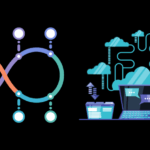
Automating DevOps Services transforms your software development cycle, offering end-to-end automation for faster deployments and enhanced operational efficiency.
DevOps is a software development approach that emphasizes collaboration between teams and automated workflows to deliver software faster and with higher quality. Automation plays a crucial role in achieving these goals.
In this post:
- Automating DevOps processes can help businesses improve efficiency and reduce time-to-market.
- Popular DevOps tools can be used for automation.
Understanding DevOps Automation
Automation is a critical element in the DevOps philosophy. It enables organizations to streamline processes, improve efficiency, and increase speed to market. Automating DevOps processes also helps eliminate errors and maintain consistency across systems and environments.
In order to implement automation in DevOps workflows, organizations need to utilize various tools and technologies. These tools assist in automating tasks such as building, testing, and deploying software. Popular DevOps tools for automation include Jenkins, Puppet, Chef, Ansible, and SaltStack, among others.
For instance, Jenkins is an open-source automation server that allows developers to automate various aspects of the software delivery process. It offers hundreds of plugins to support building, testing, and deploying applications. Using Jenkins in conjunction with other tools like Ansible or Puppet enables a more comprehensive automation solution.
Similarly, Ansible is an open-source automation tool used for configuration management, application deployment, and task automation. It automates repetitive tasks, making it easier to manage and scale IT infrastructure. Ansible can help organizations maintain consistency and speed up the process of deploying software.
Understanding DevOps Automation with Code Examples
Let’s say an organization wants to deploy an application to a server. This process would typically involve several manual steps, such as creating a virtual machine, installing software dependencies, configuring the environment, and deploying the application. Automating these steps can not only speed up the process but also reduce the risk of errors.
| Manual Process | Automated Process |
|---|---|
| Create a VM manually | Use a tool like Ansible to create a VM automatically |
| Install dependencies manually on the VM | Use Ansible to install dependencies on the VM automatically |
| Configure the environment manually | Use Ansible to configure the environment automatically |
| Deploy the application manually | Use Jenkins to build and deploy the application automatically |
As shown in the example, automation tools like Ansible and Jenkins can significantly reduce manual tasks and eliminate errors in the DevOps workflow.
Benefits of DevOps Automation Services

DevOps automation services are a crucial component of modern software delivery methodologies. By automating repetitive tasks, organizations can increase efficiency, reduce errors, and improve product quality. Below are some of the key benefits of using DevOps automation services.
Improved Productivity: By automating tedious tasks, such as testing and deployment, teams can focus on more meaningful work. This results in improved productivity and faster software delivery.
Reduced Time-to-Market: Automated workflows can significantly reduce the time it takes to release new features and updates, giving organizations a competitive edge.
Better Software Quality: Automation ensures that every release is thoroughly tested and free of errors. This leads to higher levels of customer satisfaction and retention.
Consistent Processes: Automation ensures that processes are executed consistently across environments, reducing the risk of errors and failures.
By leveraging DevOps automation services, organizations can achieve these benefits and streamline their software delivery pipelines.
Implementing DevOps Automation in Your Organization
Implementing DevOps automation in your organization requires careful planning and consideration. Here are some steps you can follow to successfully automate your DevOps processes:
- Evaluate your current processes. Before automating, it’s important to assess your current processes and identify areas that can be improved through automation. This will help you determine which automation tools are most suitable for your organization.
- Select the right DevOps automation service provider. Choose a provider with experience and expertise in your industry and the specific automation tools you plan to use. Look for a provider that offers ongoing support and training to ensure a successful implementation.
- Choose the right automation tools. There are many DevOps tools available for automation, each with its own strengths and weaknesses. Consider factors such as ease of use, integration with existing tools, and scalability when selecting your automation tools.
- Develop a roadmap for implementation. Identify the tasks that will be automated first, and create a timeline for implementation. This will allow you to track progress and ensure a smooth transition to automated processes.
- Train your team. Adequate training is crucial to the success of your implementation. Ensure that your team members are familiar with the new tools and processes, and provide ongoing training to keep them up-to-date with any changes.
- Continuously monitor and optimize. Once your automation processes are in place, it’s important to continuously monitor and optimize them. This will help you identify and address any issues that may arise, and ensure that your processes remain efficient and effective over time.
By following these steps, you can successfully implement DevOps automation in your organization, improving efficiency and streamlining your software delivery processes.
Common Challenges in DevOps Automation

Automating DevOps processes can be a challenge, with various complexities that can arise during the implementation phase.
Integration Complexities
One of the most common challenges when it comes to automating DevOps processes is the integration of different tools. Organizations may use different tools for different phases of the DevOps workflow, and these tools may not necessarily work well together. This can cause issues with integration, which can lead to delays and errors.
To overcome this challenge, it is important to carefully evaluate each tool and ensure that they can integrate seamlessly with each other. This may involve customizing tools or using third-party integrations to ensure that they work together smoothly.
Tool Selection
Another challenge is selecting the right tools for automating DevOps processes. There are numerous automation tools available in the market, and choosing the right one can be overwhelming. Organizations need to select tools that are flexible, scalable, and can integrate well with other tools in their workflow. Additionally, organizations need to consider the level of expertise required to implement and maintain these tools.
To overcome this challenge, it is important to evaluate each tool based on its functional capabilities, level of expertise required, and ease of maintenance. Additionally, organizations can seek the guidance of experts who can help in selecting the best tools for their specific needs.
Resistance to Change
Finally, resistance to change can also be a challenge when it comes to automating DevOps processes. Employees may be used to working in a certain way, and introducing automation can disrupt their daily routines. This can lead to resistance and reluctance to adopt new processes.
To overcome this challenge, it is important to communicate the benefits of automation and involve employees in the implementation process. Employees need to be trained on how to use the new tools and processes, and they need to be reassured that automation is intended to improve their productivity and streamline their work.
Best DevOps Automation Practices

Implementing DevOps automation requires careful planning and execution. The following best practices can help organizations ensure a successful automation roll-out.
1. Adopt Continuous Integration (CI) and Continuous Deployment (CD)
CI and CD are essential components of DevOps automation. CI involves integrating code changes into a shared repository and validating the changes through automated build and test processes. CD ensures that validated changes are automatically deployed to production environments. These practices help teams catch errors early, reduce manual effort, and deliver software more frequently and consistently.
2. Use Version Control for Code Management
Version control is critical for managing code changes and ensuring code integrity. By using a version control system, teams can track changes to code over time, collaborate effectively, and revert to previous versions if needed. Popular version control systems include Git, SVN, and Mercurial.
3. Implement Automated Testing
Automated testing is essential to ensure consistent and reliable software quality. By automating unit testing, functional testing, and performance testing, teams can catch bugs early and avoid costly production issues. Common automated testing frameworks include JUnit, Selenium, and Cucumber.
4. Integrate Tools for Monitoring and Alerting
Monitoring and alerting tools help teams proactively identify and resolve issues in production environments. By integrating tools such as Nagios, Zabbix, or Prometheus, teams can monitor system health, track performance metrics, and receive timely alerts when issues arise.
5. Document Processes and Procedures
Documenting processes and procedures is essential to ensure consistency and repeatability in DevOps automation. By creating clear documentation, teams can help new members get up to speed quickly, avoid misunderstandings, and reduce the risk of errors.
By following these practices, organizations can realize the full benefits of DevOps automation services and improve their software delivery capabilities.
Choosing the Right DevOps Automation Service Provider
Choosing the right DevOps automation service provider is crucial for a successful implementation. Here are some key factors to consider:
- Experience: Look for providers with extensive experience in DevOps automation. Check their portfolio and customer testimonials to gauge their level of expertise and understanding of the field.
- Expertise: Ensure that the provider has the necessary skills and resources to handle your specific automation needs. Consider their knowledge of your industry, their technical capabilities, and their ability to customize solutions to fit your unique requirements.
- Support: It is important to choose a provider that offers comprehensive support throughout the automation process. This includes training, maintenance, and troubleshooting. Check if the provider offers 24/7 support and if they have a strong customer service record.
When evaluating different service providers, ask for detailed proposals and compare their offerings and pricing. It is also advisable to conduct interviews or meetings to gauge their communication skills and alignment with your business objectives.
Conclusion: Embracing DevOps Automation for Success
In today’s fast-paced business landscape, automating DevOps processes is becoming increasingly vital for seamless software delivery. By embracing DevOps automation services, organizations can significantly enhance their productivity, reduce time-to-market, and improve software quality.
It’s clear that DevOps automation is the way forward for organizations that want to stay competitive. By automating DevOps processes, businesses can achieve faster releases, better quality, and increased efficiency.
To succeed in today’s digital landscape, it’s crucial to stay ahead of the curve and embrace the possibilities of automation. So, start exploring the potential of DevOps automation services for your organization today!
FAQ

Q: What is DevOps automation?
A: DevOps automation encapsulates the use of automation tools and practices to streamline and accelerate the development and operations process.
Q: How can automation help in DevOps?
A: Automation in DevOps can help eliminate manual and repetitive tasks, reduce human error, increase the reliability of deployments, and accelerate the overall software development process.
Q: What are the benefits of using DevOps automation?
A: Using DevOps automation drives faster and more efficient software development practices, improves collaboration between development and operations teams, enables continuous delivery, and promotes a culture of agility and automation.
Q: How does automation accelerate the development life cycle?
A: Automation frees up developers and operations teams from routine tasks, reducing the need for human intervention and allowing them to focus on higher-value activities. This ultimately speeds up the development life cycle.
Q: What are some common automation tools used in DevOps?
A: Some common automation tools used in DevOps include Kubernetes, open-source automation platforms, and trending automation tools and platforms that are tailored for specific DevOps practices and workflows.
Q: How can DevOps automation help in managing cloud infrastructure?
A: DevOps automation can help in managing cloud infrastructure by automating the provisioning and configuration of resources, ensuring consistency, scalability, and efficiency in deploying applications and services.
Q: What is the role of automation in DevOps culture?
A: Automation is a key enabler of DevOps culture. It encourages the use of feedback loops, continuous integration and delivery, and increased collaboration between development and operations teams.
Q: How can I get started with DevOps automation?
A: To get started with DevOps automation, it is advisable to first understand the best practices and principles of DevOps, explore the trending automation tools and platforms, and gradually implement automation in your software development process.
Q: How does automation in DevOps help in reducing human error?
A: Automation in DevOps reduces the reliance on manual processes, minimizing the chances of human error. By automating routine tasks, the risk of mistakes caused by human intervention is significantly reduced.
Q: How can automation in DevOps help improve the overall reliability of deployments?
A: Automation in DevOps ensures that deployments are consistent, repeatable, and can be easily reproduced. By eliminating manual steps and relying on automated processes, the overall reliability of deployments is improved.
Noah is an accomplished technical author specializing in Operations and DevOps, driven by a passion ignited during his tenure at eBay in 2000. With over two decades of experience, Noah shares his transformative knowledge and insights with the community.
Residing in a charming London townhouse, he finds inspiration in the vibrant energy of the city. From his cozy writing den, overlooking bustling streets, Noah immerses himself in the evolving landscape of software development, operations, and technology. Noah’s impressive professional journey includes key roles at IBM and Microsoft, enriching his understanding of software development and operations.
Driven by insatiable curiosity, Noah stays at the forefront of technological advancements, exploring emerging trends in Operations and DevOps. Through engaging publications, he empowers professionals to navigate the complexities of development operations with confidence.
With experience, passion, and a commitment to excellence, Noah is a trusted voice in the Operations and DevOps community. Dedicated to unlocking the potential of this dynamic field, he inspires others to embrace its transformative power.







